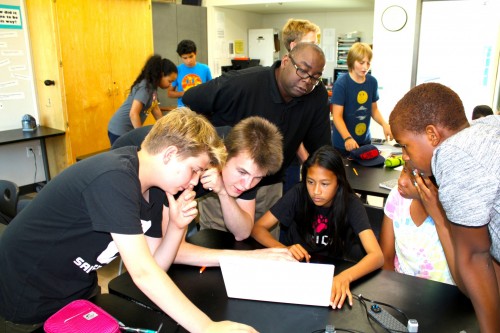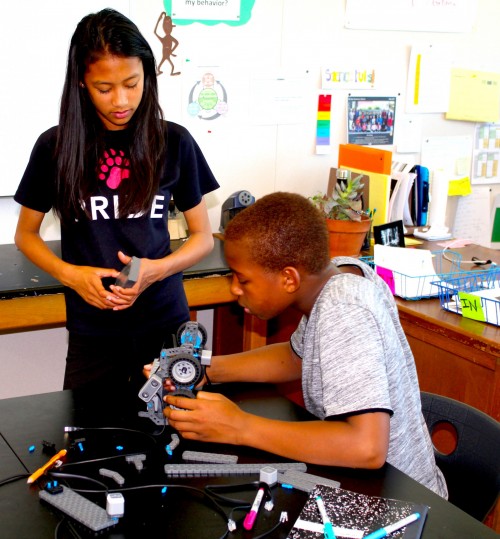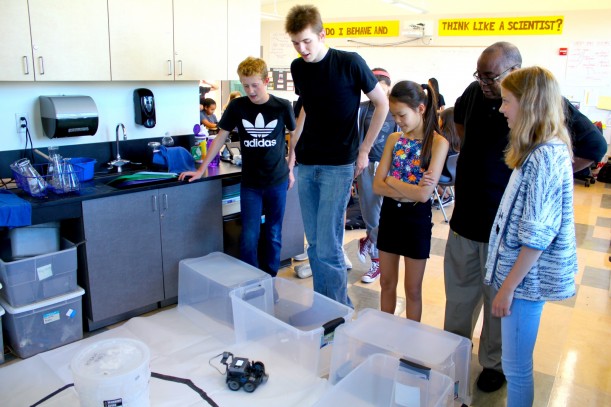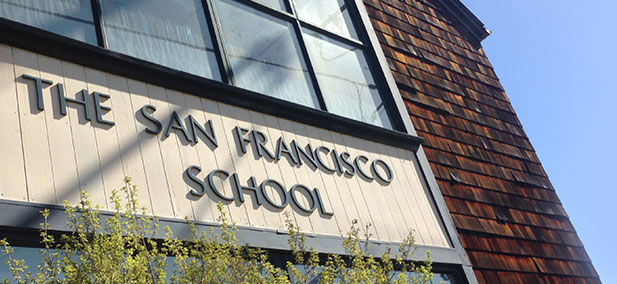SFS Alum Helps Bring Robotics to Life
Tagged with:
Alec Grey ’09 partnered with 7th/8th Grade Science teacher Eugene Stampley to create a unique robotics unit for the 8th Grade students.
“This is an instance where I say to kids that the process is more important than the final product,” says Eugene Stampley, 7th and 8th Grade Science Teacher. Alumnus Alec Grey nods and agrees. “I think their grades on this project should depend more on the depth of their understanding than on their results,” he adds, “and on how well they can reflect on what could be changed in their designs.”
Stampley and Grey joined forces this fall to work on a brand-new robotics unit, teaching the 8th graders the basics of robotics programming, in which standard computer programming fundamentals are also applicable. Students learned to use the VEX Robotics Design System, a building block system similar to Lego and used in robotics competitions worldwide. They also learned to use Modkit, a software program used for programming robots, similar to a physical representation of the computing language C++.

The teachers modeled the risk and resilience involved in the engineering design process by each taking on new personal challenges - classroom teaching for college engineering student Grey; robotics for veteran teacher Stampley - and sharing their struggles and growth with the students. “It’s really hard as a teacher to give up that control of what the kids learn, and say, ‘I don’t know that,’” notes Stampley. “But I’ve found that it’s a healthy way to build relationships with kids: to say, ‘I don’t know - BUT let’s find out together!’” Grey notes, “Them watching someone so educated learn something new is so valuable and educational in itself - they see what kinds of questions he asks, the research he does, how he applies what he knows to get somewhere new.”
Thinking back on his time at SFS, Grey recalls former 5th grade teacher Francisco Hernandez’s “Systems” unit particularly vividly, in which students would take apart bicycles, computers, vacuum cleaners, etc., try to figure out what each component did, and then try to reconstruct them. “I was a kid who was doing that kind of thing at home - I’d had a tool kit since I was eight - so having an avenue to actually apply that at school was really interesting. I wasn’t necessarily the strongest student in some other areas, so getting to feel ‘really good’ at something at school was new.”

The project culminated in a design challenge, in which Grey and Stampley built a 6 foot-by-6-foot square with obstacles (such as a wall) and required students to program their robots to navigate the course while avoiding or dealing with the obstacles. But the challenge was almost the icing on the cake for the two teachers. “It almost doesn’t matter whether they’re successful with the challenge itself; it’s how they work together as a team,” says Grey. Adds Stampley, “Seeing how excited, how engaged students have been during this unit - their cooperation, their collaboration, their flexible thinking - that’s been the best part of all.”

Posted October 16, 2017



